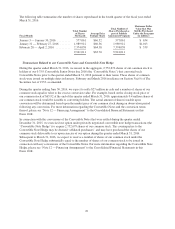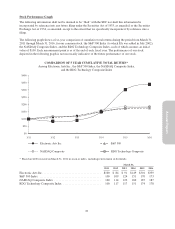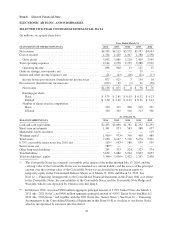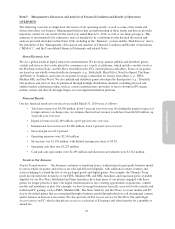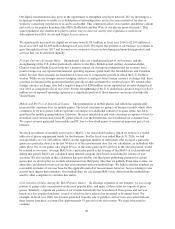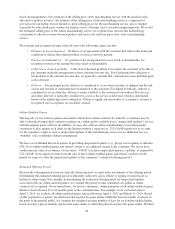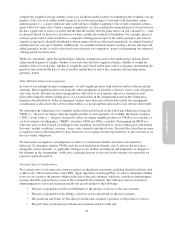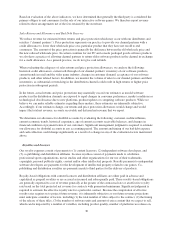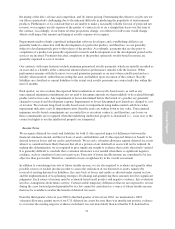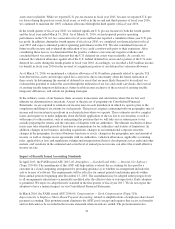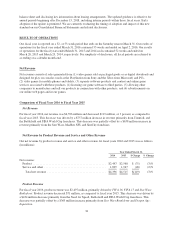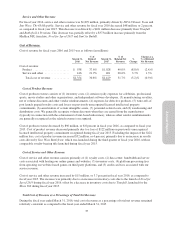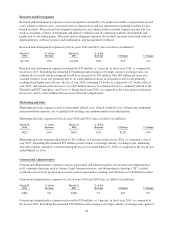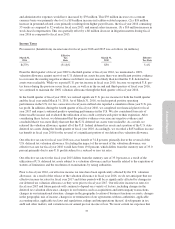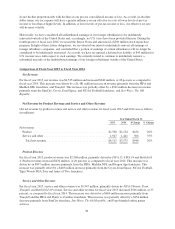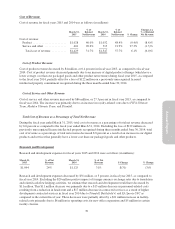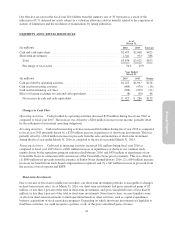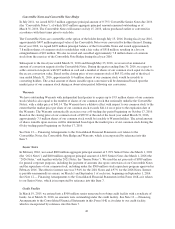Electronic Arts 2016 Annual Report Download - page 118
Download and view the complete annual report
Please find page 118 of the 2016 Electronic Arts annual report below. You can navigate through the pages in the report by either clicking on the pages listed below, or by using the keyword search tool below to find specific information within the annual report.
assets were realizable. While we reported U.S. pre-tax income in fiscal year 2015, because we reported U.S. pre-
tax losses during the previous seven fiscal years, as well as in the second and third quarters of fiscal year 2016,
we continued to maintain the 100% valuation allowance through the third quarter of fiscal year 2016.
In the fourth quarter of fiscal year 2016, we realized significant U.S. pre-tax income for both the fourth quarter
and the fiscal year ended March 31, 2016. As of March 31, 2016, we had reported positive operating
performance in the U.S. for two consecutive fiscal years and had also reported a cumulative three-year U.S. pre-
tax profit. In addition, during the fourth quarter of fiscal year 2016, we completed our financial plan for fiscal
year 2017 and expect continued positive operating performance in the U.S. We also considered forecasts of
future taxable income and evaluated the utilization of tax credit carryforwards prior to their expiration. After
considering these factors, we determined that the positive evidence overcame any negative evidence and
concluded that it was more likely than not that the U.S. deferred tax assets were realizable. As a result, we
released the valuation allowance against all of the U.S. federal deferred tax assets and a portion of the U.S. state
deferred tax assets during the fourth quarter of fiscal year 2016. Accordingly, we recorded a $453 million income
tax benefit in fiscal year 2016 for the reversal of a significant portion of our deferred tax valuation allowance.
As of March 31, 2016, we maintained a valuation allowance of $114 million, primarily related to specific U.S.
state deferred tax assets and foreign capital loss carryovers, due to uncertainty about the future realization of
these assets. In determining the amount of deferred tax assets that are more likely than not to be realized, we
evaluated the potential to realize the assets through the utilization of tax loss and credit carrybacks, the reversal
of existing taxable temporary differences, future taxable income exclusive of the reversal of existing taxable
temporary differences, and certain tax planning strategies.
In the ordinary course of our business, there are many transactions and calculations where the tax law and
ultimate tax determination is uncertain. As part of the process of preparing our Consolidated Financial
Statements, we are required to estimate our income taxes in each jurisdiction in which we operate prior to the
completion and filing of tax returns for such periods. This process requires estimating both our geographic mix of
income and our uncertain tax positions in each jurisdiction where we operate. These estimates involve complex
issues and require us to make judgments about the likely application of the tax law to our situation, as well as
with respect to other matters, such as anticipating the positions that we will take on tax returns prior to our
actually preparing the returns and the outcomes of disputes with tax authorities. The ultimate resolution of these
issues may take extended periods of time due to examinations by tax authorities and statutes of limitations. In
addition, changes in our business, including acquisitions, changes in our international corporate structure,
changes in the geographic location of business functions or assets, changes in the geographic mix and amount of
income, as well as changes in our agreements with tax authorities, valuation allowances, applicable accounting
rules, applicable tax laws and regulations, rulings and interpretations thereof, developments in tax audit and other
matters, and variations in the estimated and actual level of annual pre-tax income can affect the overall effective
income tax rate.
Impact of Recently Issued Accounting Standards
In April 2015, the FASB issued ASU 2015-05, Intangibles — Goodwill and Other — Internal-Use Software
(Topic 350-40). The amendments of this ASU will help entities evaluate the accounting for fees paid by a
customer in a cloud computing arrangement by providing guidance as to whether an arrangement includes the
sale or license of software. The requirements will be effective for annual periods (and interim periods within
those annual periods) beginning after December 15, 2015. The amendment may be adopted either prospectively
to all arrangements entered into or materially modified after the effective date or retrospectively. Early adoption
is permitted. We expect to adopt this new standard in the first quarter of fiscal year 2017. We do not expect the
adoption to have a material impact on our Consolidated Financial Statements.
In March 2016, the FASB issued ASU 2016-09, Compensation — Stock Compensation (Topic 718):
Improvements to Employee Share-Based Payment Accounting, related to simplifications of employee share-based
payment accounting. This pronouncement eliminates the APIC pool concept and requires that excess tax benefits
and tax deficiencies be recorded in the income statement when awards are settled. The pronouncement also
32


